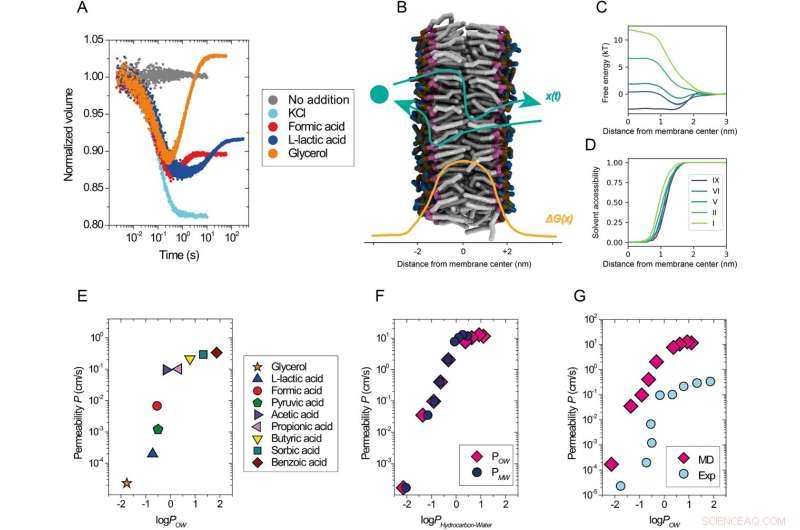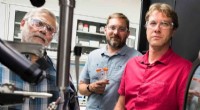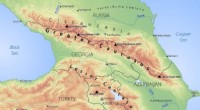Hvordan celler kontrollerer deres grænser

Permeabilitet af opløste stoffer som en funktion af deres lipofilicitet. En oversigt over eksperimentel assay. Kinetiske data opnået med calcein-selv-quenching-assayet ved hjælp af vesikler sammensat af DOPC blandet med buffer (grå) eller osmotisk chokerede med 52,5 mM KCl (cyan), 50 mM natriumformiat (rød), 50 mM natrium-L-lactat (blå) eller 120 mM glycerol (orange) ved 20 °C. B Skematisk beskrivelse af permeationsprocessen, x(t), gennem en lipidmembran med et eksempel på en fri energiprofil, ΔG(x) (lipidhaler, grå; glyceroldel, lilla; phosphatdel, okker; og cholindel, blå; vandmolekyler er ikke vist). C Udvalgte fri energiprofiler fra simuleringer af opløste stoffer med varierende hydrofobicitetsniveauer (I mest hydrofile, IX mest hydrofobiske), der trænger gennem en DOPC lipidmembran som funktion af afstanden fra dobbeltlagscentret langs membranen. Kun halvdelen af hele den symmetriske permeationsprofil er vist. D Opløsningsmiddeltilgængelighedsprofiler for de permeerende opløste stoffer langs permeationsvejen. Opløste stoffer interagerer med opløsningsmiddelmolekyler selv dybt i membranhaleregionen (x < 1,0 nm). E–G Permeabilitetskoefficienter for DOPC-membraner fra eksperimenter ved 20 °C (E, G) og simuleringer (F, G) plottet mod logaritmen af oktanol/vand (logPOW ) og membran/vand-fordelingskoefficient (logPMW ) af de opløste stoffer. Opløste stoffer af de hydrofobe niveauer I (logPOW = −2.14) til IX (logPOW = 1,1) blev brugt i simuleringerne. LogP er log10 (fordelingskoefficient), hvor P refererer til ligevægtsfordelingen af et molekyle mellem den hydrofobe og hydrofile fase af to ublandbare opløsningsmidler. Den eksperimentelle logPOW værdier for svage syrer og glycerol (E, G) blev taget fra PubChem-databasen (https://pubchem.ncbi.nlm.nih.gov/). Den simulerede logPOW værdier (F, G) blev taget fra arbejde25; logPMW værdier (F) blev opnået fra de foreliggende simuleringer. Fordelingskoefficienterne er relateret til den frie energiforskel mellem de respektive faser. I tilfælde af PMW , dette er forskellen mellem membrancentret og opløsningsmiddelfasen. Værdierne af den frie energi er præsenteret i (C). Kredit:Nature Communications (2022). DOI:10.1038/s41467-022-29272-x
Bakterier, svampe og gær er meget gode til at udskille nyttige stoffer såsom svage syrer. One way in which they do this is through passive diffusion of molecules across the cell membrane. At the same time, cells need to prevent leakage of numerous small molecules. Yeast cells, for instance, can live in hostile environments thanks to a very robust and relatively impermeable membrane system. Biochemists at the University of Groningen have studied how the composition of the membrane affects passive diffusion and the robustness of the cell membrane. Their results, which were published in Nature Communications on March 25, could help the biotech industry to optimize microbial production of useful molecules and help in drug design.
Border control is very important to cells. Their membranes separate the inner and outer environments, which are quite different. To absorb useful compounds, such as nutrients, or to excrete waste, cells can use selective transport systems. However, some transport across the membrane takes place by passive diffusion. This is a non-selective process that will let some molecules go in or out, depending on their size and hydrophobicity, for example. Active transporters have been studied extensively; however, our knowledge of passive diffusion through the membrane is still very incomplete.
Synthetic vesicles
This is a problem for the biotechnology industry, which uses cells as factories to produce a myriad of useful substances and that needs these worker cells to survive under harsh conditions, for example in an environment with a high alcohol or weak acid concentration. Bert Poolman, Professor of Biochemistry at the University of Groningen, was approached by a biotech company that was interested in producing lactic acid in bacteria. They wanted to know more about passive diffusion. This fitted in nicely with another project that Poolman is working on. "We are highly interested in these passive transport processes because of our involvement in a project to build a synthetic cell," says Poolman. "If you can use passive diffusion instead of an active transport system, you need fewer parts to construct such a cell."
So, he combined both questions in a research project. "We started out with a systematic study of what causes the differences in permeability of yeast membranes and bacterial membranes," says Poolman. His team created synthetic vesicles that were made up of three to four different lipids. Ergosterol or cholesterol was added to the membranes to affect their fluidity and rigidity. A range of small molecules was tested using this system and the results from these experiments guided molecular dynamic simulations of diffusion through membranes. The in-silico studies, supervised by Professor Siewert-Jan Marrink, provided a deeper insight into the molecular mechanism of diffusion.
Tweaking
The fatty acid tails of the lipids turned out to be most important in determining the properties of membranes, whereas the hydrophilic head groups had little effect on the permeability. The length of the tails also mattered. "And saturated tails, with no double carbon bonds, are stiffer than unsaturated ones. Hydrophobic interactions cause a close packing of these tails, resulting in a gel phase that is not very penetrable," explains Poolman. Sterols increase the fluidity but in the case of yeast, which uses ergosterol, the permeability remains low. "Thus, by tweaking the saturation of the fatty acids and the type and amount of sterol in the membrane, we can modify the permeability of the plasma membrane of yeast and bacterial cells."
Poolman and his colleagues have, therefore, defined a number of variables that alter the permeability of membranes for different classes of compounds. This information can be used by companies that use yeasts or bacteria as cell factories. "However, our results cannot be directly applied to those cells," says Poolman. "Real membranes contain hundreds of different lipids and the composition can vary between different locations in the membrane. In addition, these cell membranes contain all kinds of proteins. If you make changes in, for example, the lipid composition of the membrane, a lot can go wrong and the function of a membrane protein can be affected."
Drug design
The increased understanding of the physical processes that affect permeability can help companies to understand why certain cells are better for specific processes than others. "The usual way to tweak strains is by directed evolution. Our results will help companies to better understand the results of those optimizations and guide their cell engineering efforts."
Another application is the design of drugs that act inside cells. "Pharmaceutical companies use a set of empirically established rules to optimize drugs for action inside cells, based on parameters such as size or polarity. Our study highlights the importance of the membrane composition of the targeted cells and this could help in drug design."
 Varme artikler
Varme artikler
-
 Enzymer værd for biobrændstoffer vist i seneste forskningNREL-forskerne Michael Himmel (til venstre), Roman Brunecky, og Yannick Bomble med røntgendiffraktionskilden anvendt til at bestemme strukturen af C. bescii CelA-cellulasen. Kredit:Dennis Schroeder/
Enzymer værd for biobrændstoffer vist i seneste forskningNREL-forskerne Michael Himmel (til venstre), Roman Brunecky, og Yannick Bomble med røntgendiffraktionskilden anvendt til at bestemme strukturen af C. bescii CelA-cellulasen. Kredit:Dennis Schroeder/ -
 En bedre måde at vaske pesticider af æblerKredit:Charles Rondeau/public domain Polering af et æble med din skjorte kan fjerne støv og snavs, men at slippe af med pesticidrester kan tage lidt mere arbejde. Forskere rapporterer nu i ACS J
En bedre måde at vaske pesticider af æblerKredit:Charles Rondeau/public domain Polering af et æble med din skjorte kan fjerne støv og snavs, men at slippe af med pesticidrester kan tage lidt mere arbejde. Forskere rapporterer nu i ACS J -
 Hvad betyder kaukasisk egentlig?Større Kaukasus -regionen er, hvor kaukasiere - ægte kaukasiere - kalder hjem. Folk fra Georgien, Rusland, Aserbajdsjan og Armenien hagler fra området. FreeWorldMaps.net En gang imellem, på en af d
Hvad betyder kaukasisk egentlig?Større Kaukasus -regionen er, hvor kaukasiere - ægte kaukasiere - kalder hjem. Folk fra Georgien, Rusland, Aserbajdsjan og Armenien hagler fra området. FreeWorldMaps.net En gang imellem, på en af d -
 FN's højsø-biodiversitetstraktat kæmper for at forlade havnenMange havde håbet, at den femte forhandlingssession om en traktat om havbiodiversitet for internationale farvande, som begyndte den 15. august 2022 i FNs hovedkvarter i New York, ville have været den
FN's højsø-biodiversitetstraktat kæmper for at forlade havnenMange havde håbet, at den femte forhandlingssession om en traktat om havbiodiversitet for internationale farvande, som begyndte den 15. august 2022 i FNs hovedkvarter i New York, ville have været den
- Et gennembrud inden for katalysatorer:Mindre end nanoskala
- UD-forskere forsøgte først med 3D-kulstof nanorør-arkitekturer
- Teams større og bedre pincetur er superstabilt
- Hvordan pandemitrætte forældre kan lade op og komme i kontakt med børn uden ferie
- Fiat Chrysler vejer potentielle fusioner mellem Europa og Asien
- På en campingvogn, med en af Saharas sidste europæiske opdagelsesrejsende


